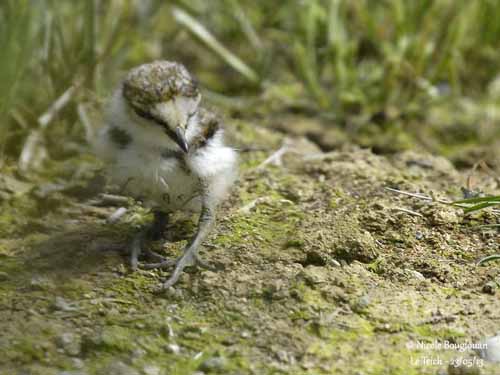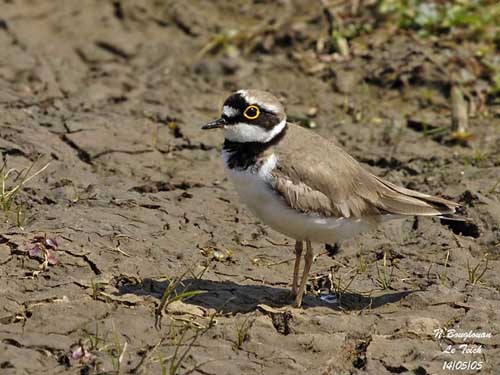
Fr: Petit gravelot
All : Flußregenpfeifer
Esp: Chorlitejo Chico
Ital: Corriere piccolo
Nd: Kleine Plevier
Sd: Mindre strandpipare
Photographers:
John Anderson
John Anderson Photo Galleries
Nicole Bouglouan
PHOTOGRAPHIC RAMBLE
Text by Nicole Bouglouan
Sources:
HANDBOOK OF THE BIRDS OF THE WORLD Vol 3 by Josep del Hoyo-Andrew Elliott-Jordi Sargatal - Lynx Edicions - ISBN : 8487334202
SHOREBIRDS by Peter Hayman, John Marchant and Tony Prater – Christopher Helm – 1986 – ISBN: 0747014035
GUIDE DES LIMICOLES de D. Taylor - Delachaux et Niestlé - ISBN : 2603014080
BirdLife International (BirdLife International)
Sungei Buloh Wetlands Reserve (Michael Mastaller)
Birds of Britain - The Web Magazine for Birdwatchers
What Bird-The ultimate Bird Guide (Mitchell Waite)
Little Ringed Plover
Charadrius dubius
Charadriiforme Order – Charadriidae family
INTRODUCTION:
The Little Ringed Plover is a small shorebird with bold black-and-white head and breast patterns, used in aggressive encounters and courtship displays.
DESCRIPTION OF THE BIRD:
Biometrics:
Length: 14-17 cm
Wingspan- 30-33 cm
Weight: 26-53 g
The adult in breeding plumage has brownish upperparts and white underparts.
The male has black collar, larger on the breast. Chin and throat are white, extending to white collar above the black one.
It differs from the closely related Charadrius hiaticula by the frontal pattern, with black frontal bar separated from the brown crown by a white stripe which is absent in C. hiaticula. The black head pattern also forms a mask extending to the ear-coverts.
The bill is black. The eyes are dark brown with conspicuous bright yellow eyering. Legs and feet are pinkish.

The female in breeding plumage has slightly narrower eyering, and the breast band is washed brownish.
Both adults in non-breeding plumage show more dark brown than black pattern, and mainly in breast band. We can see a buffy tinge on forehead and supercilium.
The juvenile is brownish with much duller head pattern and plumage than adults. The breast band is often broken in two lateral patches. The upperparts are paler than in adults with buffy feather edges involving scaled effect. The eyering is dull yellow. Legs and feet are yellowish.
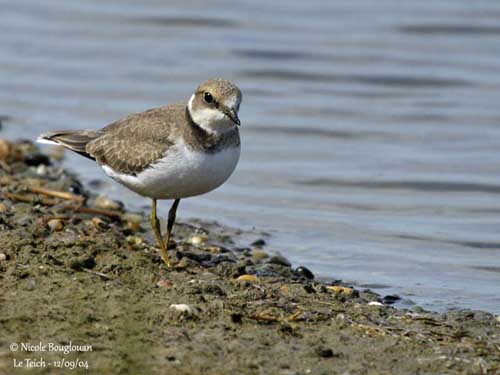
The downy chick is white mottled cinnamon, grey and blackish. Its general pattern resembles that of adults.
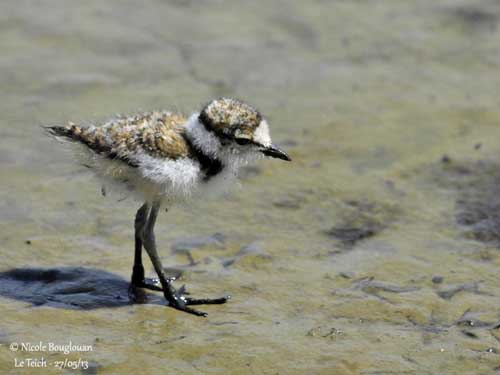
SUBSPECIES AND RANGE:
The Little Ringed Plover has three subspecies.
C.d. curonicus (here displayed) is found in Eurasia, from British Islands, N Africa and Canary islands to Russian Far East, Korea, E China and Japan. It winters in Africa, South of Sahara, Arabia, E China and Indonesia.
In breeding plumage, the adults of this race have reduced brownish breast band and brownish head pattern.
C.d. jerdoni is found in India and SE Asia. It is similar to the nominate race, but it has indistinct variation to non-breeding plumage.
C.d. dubius (here described) occurs in Philippines S to New Guinea and Bismarck Archipelago.
HABITAT:
The Little Ringed Plover occurs usually in lowlands, up to 800 metres of elevation. It breeds on bare flats of sand, shingle or silt with sparse vegetation. It is often found near fresh water. It frequents sometimes brackish lagoons and estuaries, and saline inland pools.
It is fairly rare along the coasts outside the breeding season. It has adapted to artificial sites such as gravel pits or industrial wastelands.
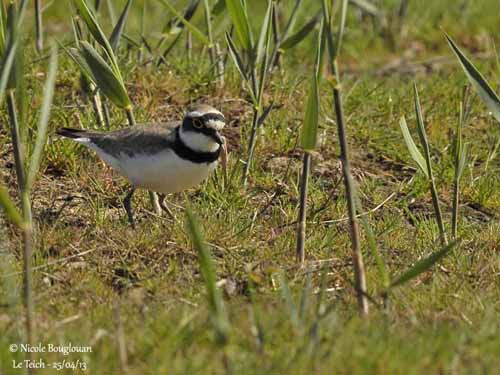
CALLS AND SONGS: SOUNDS BY XENO-CANTO
The Little Ringed Plover gives clear “peeoo” as common call, a far-carrying sound for a small bird. A short “peeu” or “cru” and insistent “pip” in alarm are usually heard.
The song is uttered early in the season, a repeated “cree-ah” which accompanies the aerial displays.
BEHAVIOUR IN THE WILD:
The Little Ringed Plover feeds mainly on various insects such as beetles, flies, ants, mayfly, dragonfly and larvae, and crickets. It also takes spiders, shrimps, small crustaceans, mussels, worms and snails.
This species forages on both dry and wet surfaces, and also in shallow water. It uses sometimes foot-trembling, but it often waits for preys coming to the surface or moving on the ground, and it runs fast to take it as soon as it is detected. It forages in tidal mudflats, pools, open short grasslands or bare ground.
It is often solitary or in pairs, and rarely joins with large flocks or at roosts with other shorebirds. They may sometimes form small groups of 10-12 birds.
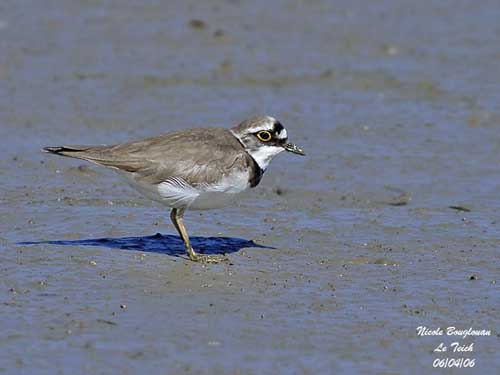
The Little Ringed Plover is territorial and often defends a good feeding area by chasing off other birds. They use the bold facial and breast patterns while displaying and fighting. During aggressive encounters, males stand facing each other, making conspicuous their facial markings. The aggressor runs towards the neighbour with head down and fanned tail. Then, both walk together, up to a metre apart, along the territory boundary. The wings are drooped towards each other, the tail is fanned and the back feathers are slightly raised.
These movements can be stopped by bouts of posturing. The bird fans the tail and tilts it slightly, the wing is drooped on the side of the opponent, ready for a strike.
This behaviour is performed to establish the territory and to defend it in non-breeding period.

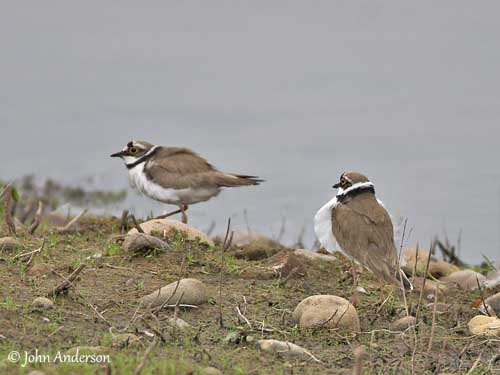
The Little Ringed Plover performs courtship display flights with butterfly-like movements. The male circles endlessly with slow wingbeats. This flight is accompanied by song, especially during steep ascents or vertical dives. Courtship displays are noisy, but this species become secretive while nesting. The black-and-white pattern is brighter during courtship.

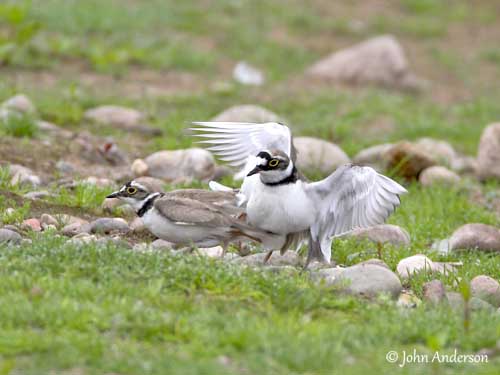
The Little Ringed Plover usually forms small groups of 10-12 birds when migrating. They fly low over the ground with rapid, direct flight.
The race “curonicus” is migratory, although there are some residents in S breeding areas. The W European populations winter in Africa, South of Sahara, whereas Siberian and Asian birds migrate to SE Asia and India where they join the resident race “jerdoni”.
The nominate race “dubius” is resident and locally nomadic in New Guinea.
The race “jerdoni” is resident with local movements according to water levels.
They often migrate singly or in small flocks of 10-12 birds.
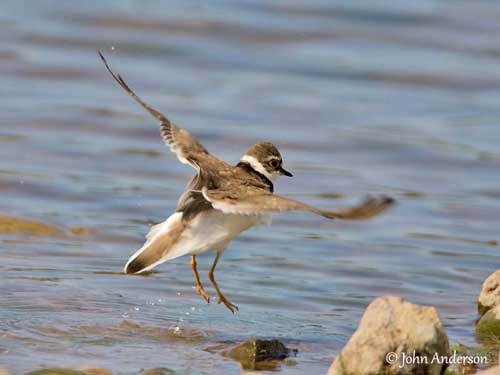
REPRODUCTION OF THIS SPECIES:
The breeding season varies with the range, April-September in Europe, and December-June in S India. They are monogamous for the first brood, and occasionally for several years. They usually nest solitary or in loose groups with well-spaced nests. They may breed near aggressive shorebirds which are able to keep predators away from the area. The Little Ringed Plover is territorial and highly aggressive.
The nest is a shallow scrape, sometimes lined with stones and some vegetation. It is made on the bare ground or in low vegetation, close to the water.

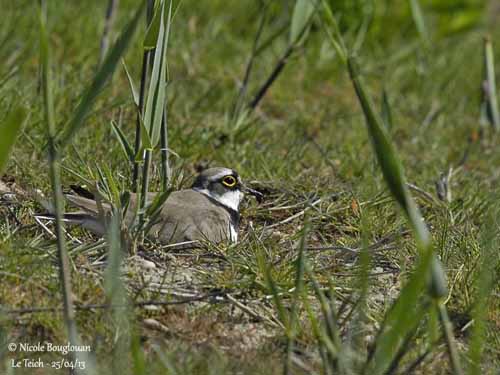
The female lays 3-4 eggs and both parents incubate during 22-28 days. There are sometimes one or two birds besides the parents, which act as helpers in nesting duties.
The chicks are precocial and leave the nest tended by both parents. They are very active, often running quickly on their long legs. They fledge 24-29 days after hatching, and are independent 8-25 days thereafter.
The female usually starts a new brood before the young have fledged. Both parents may perform the “broken-wing display” to distract predators from eggs or chicks.
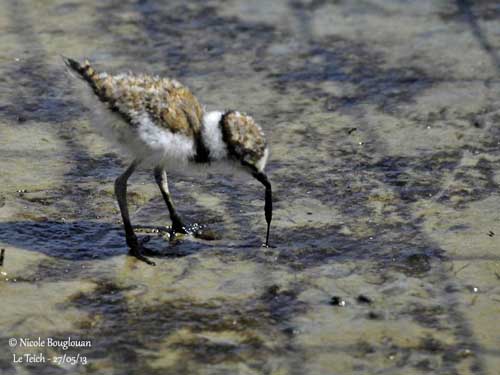
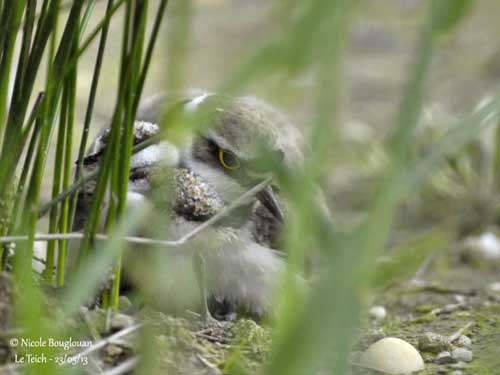
PROTECTION / THREATS / STATUS:
The Little Ringed Plover is threatened by degradation and habitat loss due to human activities and flood regulation. On the other hand, drainage and cultivation of riverine floodplains has created new suitable habitat. In addition, this species can produce up to 3 replacement clutches after losing eggs or chicks.
This species is not currently threatened and evaluated as Least Concern by BirdLife International.
